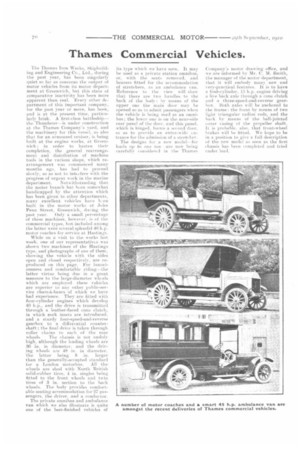Thames Commercial Vehicles.
Page 6

If you've noticed an error in this article please click here to report it so we can fix it.
The Trinities Iron Works, Shipbuilding and Engineering Co., Ltd., during the past year, has been singularly quiet so far as concerns the output of motor vehicles from its motor department at Greenwich, but this state of comparative inactivity has been more apparent than real. Every other department of this important company, tor the past year or more, has been, and is at the present time, particularly brisk. A first-class battleship— the Thunderer—is under construction at the Thames Company's yard, and the machinery for this vessel, as also that for an armoured cruiser, is being built, at the engine works, at Greenwich ; in order to hasten their completion, the general rearrangement and distribution of machine tools in the various shops, which rearrangement was commenced many months ago, has had to proceed slowly, so as not to intLiiere with the progress of urgent work in the marine
department. Notwithstanding that the motor branch har-i been somewhat handicapped by the attention which has been given to other departments, many excellent vehicles have b:eri built in the motor works at Jolin Penn Street. Greenwich, {hiring the
past year. Only a small percentage of these machines, however, is of the commercial types, tnit included among the latter were several splendid 40 h.p. motor coaches for service at Hastings.
Vi bile on a visit to the works last week, one of our representativts was shown two machines of the Hastings type, and photographs of one of them, showing the vehicle with the sides open and closed respectively. are reproduced on this page. For luxuriousness and comfortable riding—the latter virtue being due in a great measure to the large-diameter wheels which are employed-these ve.liicles are superior to any other public-service chars-it-banes of which we have had experience. They are fitted with four-cylinder engines which develop 40 h.p., and the drive is transmitted -through a leather-faced cone clutch, in which cork insets are introduced. and a sturdy four-speed-and-reverse gearbox to a differential countershaft ; the final drive is taken through roller chains to each of the rear wheels. The chassis is not unduly high, although the leading wheels are 36 in. in diameter', and the driving wheels are 48 in. in diameter, the latter being 8 in. larger than the generally-accepted standard for a London motorbus. All the wheels are shod with North British solid-rubber tires, 4 in. singles being fitted to the front wheels and twin tires of 3 in. section to the hack wheels. The body provides comfortable seating accommodation for 27 passengers, the driver, and a conductor.
The private omnilms and ambulance van which we also illustrate is quite one of the best-finished vehicles of
its type which we have seen. It may be used as a private station omnibus, or, with the seats removed, and bearers fitted for the accommodation of stretchers, as au ambulance van. Reference to the view will show that there are two handles to the back of the body : hy means of the upper one the main door may he opened so as to admit passengers when the vehicle is being used as an -omnibus; the lower one is on the near-side rear panel of the door, and this panel. which is hinged, forms a second door. So as to provide an extra-wide (Altrance for the admission of a stretcher.
The designs for a new model—for loads up to one ton are now being carefully considered in the Thames
Company..s :motor drawing office, and we are informed by Mr. C. M. Smith, the manager of the motor department, that it will embody many new and very-practical features. It is to have a four-cylinder, 15 h.p. engine driving a live back axle through a cone clutch and a three-speed-and-reverse gearbox. Both axles will be anchored to the frame the front by means of two light triangular radius rods, and the back by means of the ball-jointed outer casing of the propeller shaft,
is probable. also, that front-wheel brakes will he fitted. We hope to be in a position to give a full description of the new model as soon as the first chassis has been completed and tried rimier loud.
















